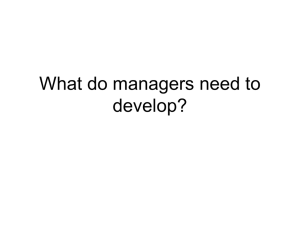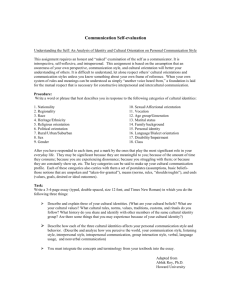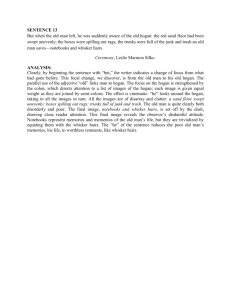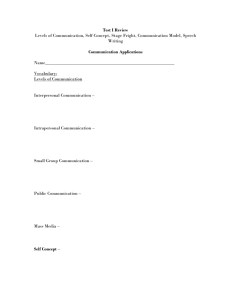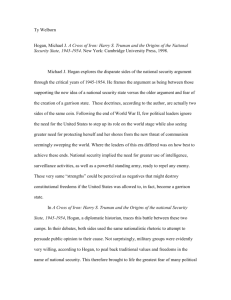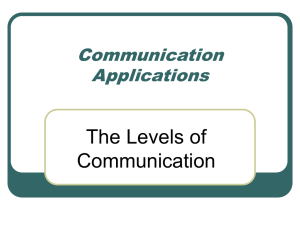Educating the Modern Manager
advertisement
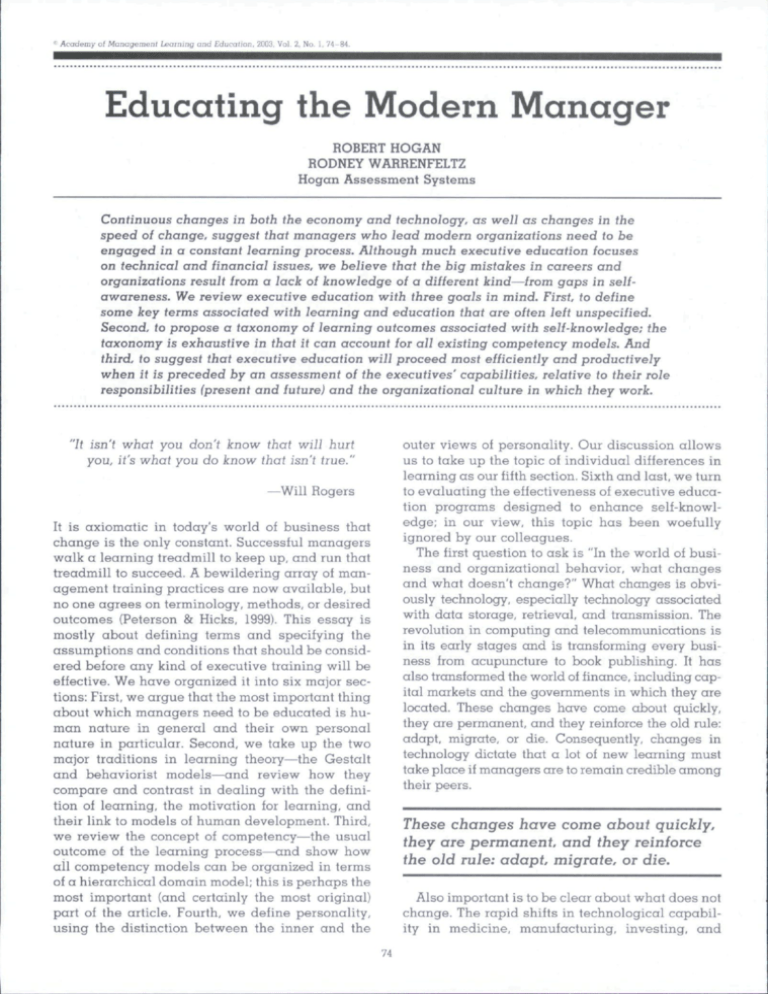
• Academy of MonagemenI
Learning and Education.
?,003. Vol. 2, No. 1
Educating the Modern Manager
ROBERT HOGAN
RODNEY WARRENFELTZ
Hogan Assessment Systems
Continuous changes in both the economy and technology, as well as changes in the
speed of change, suggest that m^anagers who lead modern organizations need to be
engaged in a constant learning process. Although much executive education focuses
on technical and financial issues, we believe that the big mistakes in careers and
organizations result from a lack of knowledge of a different kind—from gaps in selfawareness. We review executive education with three goals in mind. First, to define
some key terms associated with learning and education thai are often left unspecified.
Second, to propose a taxonomy of learning outcomes associated with self-knowledge: the
taxonomy is exhaustive in that it can account for all existing competency models. And
third, to suggest that executive education will proceed most efficiently and productively
when ii is preceded by an assessment of the executives' capabiliiies, relaiive to their role
responsibiUiies (present and future) and ihe organizational culture in which they work.
"It isn't whai you don't know that will hurt
you, it's what you do knovir that isn't true."
outer views of personality. Our discussion allows
us to take up the topic of individual differences in
learning as our fifth section. Sixth and last, we turn
to evaluating the effectiveness of executive education programs designed to enhance self-knowledge; in our view, this topic has been woefully
ignored by our colleagues.
The first question to ask is "In the world of business and organizational behavior, what changes
and what doesn't change?" What changes is obviously technology, especially technology associated
with data storage, retrieval, and transmission. The
revolution in computing and telecommunications is
in its early stages and is transforming every business from acupuncture to book publishing. It has
also transformed the world of finance, including capital markets and the governments in which they are
located. These changes have come about quickly,
they are permanent, and they reinforce the old rule:
adapt, migrate, or die. Consequently, changes in
technology dictate that a lot of new learning must
take place if managers are to remain credible among
their peers.
—Will Rogers
It is axiomatic in today's world of business that
change is the only constant. Successful managers
walk a learning treadmill to keep up, and run that
treadmill to succeed. A bewildering array of management training practices are now available, but
no one agrees on terminology, methods, or desired
outcomes (Peterson & Hicks, 1999). This essay is
mostly about defining terms and specifying the
assumptions and conditions that should be considered before any kind of executive training will be
effective. We have organized it into six major sections: First, we argue that the most important thing
about which managers need to be educated is human nature in general and their own personal
nature in particular. Second, we take up the two
major traditions in learning theory—the Gestalt
and behaviorist models—and review how they
compare and contrast in dealing with the definition of learning, the motivation for learning, and
their link to models of human development. Third,
we review the concept of competency—the usual
outcome of the learning process—and show how
all competency models can be organized in terms
of a hierarchical domain model; this is perhaps the
most important (and certainly the most original)
part of the article. Fourth, we define personality,
using the distinction between the inner and the
These changes have come about quickly,
they are permanent and they reinforce
the old rule: adapt, migrate, or die.
Also important is to be clear about what does not
change. The rapid shifts in technological capability in medicine, manufacturing, investing, and
74
Hogan and Warrenfeltz
2003
75
Robert Hogan
Rodney B. Warrenfeltz
communications create the sense that all is in flux,
the feeling that we live in Democritus' universe of
constant, swirling monadic chaos. This notion that
everything is changing is further supported by
those social theorists who argue that human nature is (a), infinitely flexible; and (b), reflecting the
changing cultural, economic, and historical conditions that surround it. This view of human malleability is related to structural sociology, cultural
anthropology, and situationist social psychology:
it regards human nature as a work in progress,
constantly molded by sociohistorical forces (typically molded for the better, by the way—cf. Degler,
1991). One consequence of this assumption of infinite human malleability is the belief that organizations can and should be structured in any way
that makes financial sense, regardless of the
wishes of the employees, who can adapt to virtually any structure. In this model, the need to adapt
creates even more demand for continuous learning.
The problem is that this view of human malleability is wrong. Human nature has a stable core;
this stable core reflects the fact that humankind is
a very old species and that people identical to us
have been around for at least 100,000 years (cf.
Pinker, 2002). Humans are, in fact, remarkably
adaptable—adaptability is part of the stable core
and one of the keys to our success as a species—
and individuals are capable of modifying certain
components of their social behavior (Peterson,
1993).
But we are not infinitely adaptable. For example,
our needs for love, companionship, status, and a
sense of meaning and purpose in our lives are
ancient desires. When these needs are frustrated
for prolonged periods—by war, economic disaster,
or just plain bad management—people become demoralized, depressed, and dysfunctional. In short,
although technology changes, human nature
doesn't, and this has important implications for
executive education. In our view, one of the most
important topics about which a newly minted military officer or MBA needs to be schooled is human
nature. Professional education in business, engineering, and science (including psychology)
largely concerns technical issues. Very little attention is given to a systematic analysis of human
nature, including the needs, aspirations, and capabilities of the students themselves. As a result,
newly minted MBAs show up at work for the first
76
Academy of Management Learning and Education
time with a major gap in their intellectual tool kits,
although they will normally believe, based on
their past experience, that they know as much as is
needed. This is the point of the Will Rogers quote
with which we began this essay.
DEFINING LEARNING AND EDUCATION
What is Learning?
Education is the end product of learning; a person
who has learned a lot is said to be educated. We
also distinguish degrees of education; a person
who is well educated has not only learned a lot
(which can be evaluated quantitatively), but also
has learned "the right things" (which is more a
matter of taste).
Learning is defined in two ways. The tradition of
phenomenology and Gestalt psychology assumes
that people construct mental models of the world
and then use the models to interpret reality and
guide their behavior. Learning is equivalent to
constructing new or enhanced mental models
(Newell & Simon, 1972; Vosniadou & Brewer, 1987).
Implicit in this tradition is the realization that mental models can be parochial, or even wrong (as
Will Rogers quipped, "Good judgment is the result
of experience, which is often the result of bad judgment"). Consider the Italian folktale Pinocchio,
which Americans see as a children's story; in fact,
it is a cautionary tale for adults. The way Pinocchio
is repeatedly duped by ruffians warns Italian
peasants that city dwellers hold superior mental
models that allow them to prey upon their less
sophisticated country cousins. For our purposes,
one form of management education concerns shaping mental models—challenging unexamined assumptions and unconscious worldviews.
On the other hand, the tradition of behaviorism,
which still dominates American psychology, defines leoining as a change in behavior after an
experience. In this view, education involves acquiring or changing behaviors. People differ in
terms of the number of behaviors they have available and their appropriateness. The concept of
skill also comes in here—a skill is a particular kind
of well-honed behavioral capacity. Defining learning in terms of skill acquisition leads to the conclusion that the Gestalt and behaviorist models of
learning concern very different phenomena. Thus,
a person could have a profound understanding of
the world but be unable to drive a car or balance a
checkbook; conversely, a person could be an accomplished athlete, musician, or chess player but
also be a bigot and a racist. In any case, proponents of the behaviorist model of learning see
March
management education as a process of acquiring
skills, with no emphasis on the process of deeper
understanding. Conversely, those of a Gestalt
model of learning see management education as a
process of constructing mental models appropriate
for interpreting organizational phenomena, with
no emphasis on the importance of concrete skills.
This is the same distinction that the British philosopher Gilbert Ryle (1948) famously drew between
the two forms of knowledge that he called "knowing that" and "knowing how."
For didactic and expository purposes, it makes
sense to distinguish between the behaviorist and
the Gestalt models of learning. In reality, however,
the distinction may be arbitrary. There are two
reasons for thinking so. First, researchers of skill
acquisition have recognized for at least 20 years
that mental rehearsal improves physical performance (cf. Heuer, 1985); this suggests that cognitive
structures underlie and guide overt behavior
(duh!). More important, the Swiss developmental
psychologist lean Piaget and the American educational psychologist John Dewey had very similar
notions about learning which can be summarized
as "thought follows action," or "we learn by doing."
In this pragmatist tradition, if we do something
successfully, we then reflect on what we have done
and create a mental model to guide our subsequent actions. Actually, the more important case
concerns doing things unsuccessfully. Nonetheless, conceptual understanding follows action, but
depends upon reflecting on the action. We find this
perspective congenial, and it has the advantage of
integrating the best insights of the behaviorist and
the Gestalt traditions in a pragmatic marriage of
convenience.
In our view, the most important lessons that executives can learn are twofold: (1) evaluating the
mental models that they hold regarding their capabilities and others' expectations of their performance; and (2) how these mental models are expressed in overt or behavioral terms (which is
social skill).
What Drives Learning?
The behaviorist and Gestalt traditions also differ
in terms of how they conceptualize the dynamics of
learning. For the behaviorists, learning is driven
by efforts to meet physiological needs (hunger,
thirst, avoidance of pain) and shaped by the hedonic and instrumental consequences of these
efforts. The mantra of the radical behaviorist
Skinnerians is "behavior is a function of its consequences." More specifically, behaviors that are rewarded (that meet physiological needs) are
2003
Hogan and Waiienfeltz
learned, and behaviors that are not rewarded are
not retained—this is the lesson of management
primers such as The One Minute Manager and Zap.
The acquisition of skills depends on the presence
or absence of rewards, not on punishments.
In the Gestalt tradition, learning is driven by
"epistemic hunger," by a desire to understand or
master the world—even at the expense of physiological needs. Here learning is primarily shaped
by errors and mistakes. For writers such as Jean
Piaget, success carries limited information value;
success means that we should continue doing
what we have been doing. It is failure that challenges our understanding and drives us to reconceptualize the world. In this Gestalt view, we learn
far more from our failures than our successes; the
reorganization of mental models depends on failures not rewards.
It is failure that challenges our
understanding and drives us to
reconceptualize the world.
77
are more important than later experiences. Our
point, however, is that these two developmental
models have quite different implications for executive learning. In the behaviorist tradition, learning new skills depends primarily on whether the
necessary prior skills are available. In the classic
tradition, however, the lessons (mental models) of
adulthood can only be learned by adults—for example, Aristotle refused to teach ethics to anyone
under the age of 30 because a degree of maturity
was needed to understand the material. Again, the
distinction between acquiring skills and constructing mental models resolves the contradiction between these two traditions of learning.
The foregoing concerns theories of development,
and the literature on the topic is fairly extensive.
Surprisingly, however, the literature on the practice of development is undeveloped to the point of
nonexistence. Hicks and Peterson (1999) present an
interesting model that describes the conditions
necessary to bring about systematic personal development, and this is a first step in the process of
turning theory into practice.
Learning and Motivation
Learning and Development
Theories of learning are often tied to models of
development, and the links depend on certain unspecified assumptions. In the behaviorist tradition,
development is essentially random and depends
on the sequence and kinds of demands that come
up during an individual life history. Specifically,
development consists of adding behaviors or skills
to one's repertoire as the skills become necessary.
The order in which the skills are acquired depends
on the order in which the problems appear in a
person's life, which of course will vary across lives.
Timing is not necessarily important, so that earlier
experiences are just earlier, not more influential.
And the path of development is bidirectional and
incremental—one can learn or unlearn skills as
appropriate, and development consists of the
steady layering of skills.
Models of learning are also tied to models of
motivation. Discussions of motivation are hopelessly confused by a lack of clarity regarding the
meaning of the key term. The word motive has
two distinct meanings. On the one hand, mofive
refers to intentions; in management by objectives, for example, people who are committed to
a program of action (i.e., who intend to follow it)
are said to be motivated. On the other hand,
motive refers to biological needs; for example, in
Maslow's system, people are motivated by certain needs, and the relevant need depends on
which of a set of five big ones has already been
satisfied. These two models of motivation—
motives as intentions and motives as biological
drives—are essentially incommensurate. This
makes it impossible to compare models of learning tied to different forms of motivation.
In the classic developmental tradition, as exemplified by Freud, Erikson, and Piaget, matters are
viewed quite differently. Here development has a
direction and an end point (from immaturity to
maturity); development is internally programmed
and spontaneously unfolds based on input from
the environment. It is stagelike and consists of
qualitative transformations over time—persons at
later stages of development are different qualitatively (they have different kinds of skills), not
quantitatively (they have more skills). Finally, in
classic developmental theory, early experiences
In our view, there are three great metamotives in
life; they derive from our evolutionary history and
are, therefore, connected to reproductive success.
At a deep and often unconscious level, people
need: (1) acceptance and approval (and are
stressed by rejection and criticism); (2) status,
power, and the control of resources (and are
stressed by their loss); and (3) predictability and
order (and are stressed by their loss). These needs
are biological, which means they are stable and
enduring, and it also means that there are individual differences in their urgency. We also believe.
78
Academy of Management Learning and Education
based on these motivational assumptions, that the
most consequential learning in life is organized
around gaining acceptance and approval (or
avoiding rejection), gaining status, power, and resource control (or minimizing their loss), and making sense of the world. II learning can be tied to
solving these problems—which we call getting
along, getting ahead, and making sense—then the
learning process assumes urgency, potency, and
emotional significance.
A DOMAIN MODEL OF MANAGERIAL
EDUCATION
In modern business-speak, the concept of skill
has morphed into the concept of competence. As
originally discussed by McClelland and his colleagues (e.g., Boyatzis, 1982), a competency is a
performance capability that distinguishes effective irom ineffective managers in a particular
organization. McClelland defined competencies
empirically, and they were specific to the requirements of a particular job in a particular
context. This clear, specific, and rigorous definition has given way to ad hoc lists of organizational competencies defined by committees.
Rather than criticize the confusions surrounding
the modern enthusiasm for competencies, we
simply observe that all lists of competencies can
be organized in terms of a "domain model" first
proposed by Warrenfeltz (1995).
Specifically, every current competency model
can be organized in terms of four competency
domains; we refer to these competencies as (1)
intrapersonal skills, (2) interpersonal skills, (3)
leadership skills, and (4) business skills. In our
view, these four domains define the content of
management education; they provide a basis for
designing curricula, assigning people to training, and evaluating management education. Finally, these four domains form a natural, overlapping developmental sequence, with the later
skills depending on the appropriate development of the earlier skills. We also think they form
a hierarchy of trainability, in which the earlier
skills are harder to train and the later skills are
easier to train.
Intrapersonal Skills
The domain of intrapersonal skills is the traditional subject matter of psychoanalysis, but a
detailed explication of that claim would take us
too far afield. Intrapersonal skills develop early
and have important consequences for career development in adulthood. This domain seems to
March
have three natural components. The first can be
described as core self-esteem (Judge, Locke,
Durham, & Kluger, 1998), emotional security, or
perhaps resiliency. People with core self-esteem
are self-confident, they have stable, positive
moods, they are not easily frustrated or upset,
and they bounce back quickly from reversals and
disappointments. Persons who lack core selfesteem are self-critical, moody, unhappy, easily
frustrated, hard to soothe, and need frequent reassurance and positive feedback. Core selfesteem is easy to measure, which means we can
give managers reliable feedback on the subject.
Moreover, measures of core self-esteem predict a
wide variety of career outcomes, including job
satisfaction and performance evaluations, which
means clients should pay attention to feedback
on this topic.
The second component of intrapersonal skills
concerns attitudes toward authority. Persons with
positive attitudes toward authority follow rules
and respect procedures; they are compliant, conforming, socially appropriate, and easy to supervise. Persons with negative attitudes toward authority ignore rules and violate procedures; they
are rebellious, refractory, and hard to supervise.
Attitudes toward authority are easy to measure
(Hogan & Hogan, 1989) and predict a wide variety
of career outcomes, including supervisors' ratings
of satisfactoriness. Thus, valid feedback on this
topic can and should be incorporated in the learning process.
The third component of intrapersonal skills is
self-control, the ability to restrain one's impulses, curb one's appetites, stay focused, maintain schedules, and follow routines. Persons with
good self-control are self-disciplined, buttoned
down, and abstemious. Persons with poor selfcontrol are impulsive, self-indulgent, and undisciplined. Self-control is easy to measure, and
measures of self-control predict a wide variety of
career outcomes (J. Hogan & Holland, in press).
Intrapersonal skill seems to be the core of the
widely popular but scientifically suspect concept
of EQ—scientifically suspect because the measurement base is so poorly developed. Intrapersonal skill is the foundation on which management careers are built. Persons with good
intrapersonal skills project integrity; from the
perspective of implicit leadership theory (i.e.,
what we expect to see in leaders), integrity is the
first and perhaps the most important characteristic of leadership (Kouzes & Posner, 1987). Successful managers receive high scores on measures of intrapersonal skills, whereas highly
effective sales people and entrepreneurs receive
2003
Hogan and Warienteltz
low scores. This is one of the interesting and significant ways in which effective managers and sales
personnel are different.
Interpersonal Skills
The domain of interpersonal skills is the traditional subject matter of role theory (Sarbin, 1954),
although a systematic elaboration of this point
would take us too far afield. People with interpersonal skills seem charming, poised, socially adept,
approachable, and rewarding to deal with.
There are four components to interpersonal
skills. The first is a disposition to put oneself in the
place of another person, to try to anticipate how
that person sees the world and what he/she expects during an interaction. Mead (1934) referred to
this as "taking the role of the other." The second
component is a skill and not a disposition; it involves getting it right when one tries to anticipate
another person's expectations. This is the topic of
accuracy in interpersonal perception (Funder,
2001), and it seems to be related to cognitive ability
and social experience—bright extraverts are more
accurate than dull introverts. The third component
of interpersonal skill involves incorporating the
information about the other person's expectations
into one's subsequent behavior. And the final component of interpersonal skill involves having the
self-control to stay focused on the other person's
expectations—here interpersonal skill overlaps
with intrapersonal skill.
Interpersonal skill concerns initiating, building,
and maintaining relationships with a variety of people who might differ from oneself in terms of age,
gender, ethnicity, social class, or political agendas.
Interpersonal skill is easily measured, and good
measures of interpersonal skill predict a wide range
of occupational outcomes, including managerial performance {cf. Hogan & Hogan, 2001; Riggio, 1989). It is
important to incorporate feedback about interpersonal skills in a training program.
Leadership Skills
The domain of leadership skills is perhaps the
most extensively studied topic in management science {for a detailed review, see R. Hogan, Curphy,
& Hogan, 1994). We believe leadership skills can be
understood in terms of five components—which
depend on intra- and interpersonal skills. Leadership skills are all about building and maintaining
effective teams. The first component concerns being able to recruit or attract talented people to a
team. This involves identifying the talent the team
actually needs and then persuading people with
79
the requisite talent to join. The second component
involves retaining talented personnel after they
have been recruited—and simply throwing money
at people won't suffice. The third component of
leadership skill concerns motivating a team—
other things being equal, a motivated team will
outperform a more talented but less motivated
group. Recruiting, retaining, and motivating team
members depend on building positive relationships with each team member—a capability that
vitally builds on the interpersonal skills developed
earlier.
The fourth component of leadership skill concerns developing, projecting, and promoting a
vision for the team. The vision legitimizes the team
enterprise, and interpersonal skills are needed to
sell it. Projecting and promoting a vision is the core
of charisma; it is through the process of adopting a
vision that people are able to transcend their selfish interests and develop what Durkheim (1925)
called impeTsonal ends for their actions. Durkheim
considered developing impersonal ends for one's
actions to be an essential feature of moral conduct.
The final component of leadership skill concerns
being persistent and hard to discourage. For example, during World War II Winston Churchill was
marvelously effective at projecting the image of
being indomitable, which was crucial to England's
survival. Persistence depends on core self-esteem
or intrapersonal skills.
Business Skills
The domain of business skills differs from the
preceding three domains in several ways. It is
the last to develop, the easiest to teach, the most
cognitive, and in an important way, the least
dependent on the ability to deal productively
with other people. Business skills involve planning, monitoring budgets, forecasting costs and
revenues, cutting costs, mapping strategies,
evaluating performance, running meetings, and
organizing necessary reports. For the most part,
these activities can be performed in private or in
an assessment center. They depend on cognitive
ability rather than on interpersonal skill, and
this is the reason people believe cognitive ability is important for managerial performance. To
the degree that organizations select and evaluate managers on the basis of cognitive ability
and business skills, and ignore the other three
competency domains, they ignore the human
side of enterprise.
80
Academy oi Management Learning and Education
To the degree that organizations select
and evaluate managers on the basis of
cognitive ability and business skills,
and ignore the other three competency
domains, they ignore the human side
of enterprise.
The Inner-Outer Distinction
We think it is important to distinguish two perspectives on a person's performance; we refer to these
as the inner and the outer perspectives. The inner
perspective concerns a person's self-view—the
person's goals and aspirations, and self-evaluations of current skills and past performance. We
refer to this as a person's identity. The outer perspective concerns how a person's performance is
evaluated by others. It concerns other people's
views of a person's skills, accomplishments, and
future potential. The domain model we have just
presented is defined in terms of ratings provided
by other people.
The inner and outer perspectives are unique and
distinct. Although most of us are largely preoccupied with the first—with our own self-evaluations,
the second—others' evaluations of our performance—is substantially more consequential in
terms of real-world payoff. For example, selfratings of leadership performance are poorly correlated with actual leadership performance (R.
Hogan, Curphy, & Hogan, 1994), although some
people are better at these self-appraisals than others. What people have to say about themselves is
largely their theory about their own performance;
it is rarely tested or evaluated, and in some cases
it is shockingly out of touch with reality. In short,
self-evaluations of performance capabilities and
successes are not very reliable data sources.
On the other hand, other peoples' evaluations
are important sources of information. Their evaluations are reliable in the sense that if they are
properly collected, they will converge. They are
relatively easy to obtain. They are related to occupational performance—indeed, other peoples'
evaluations, in a real sense, define the success of
our occupational performance. Bosses' evaluations, for example, are the primary key to salary
and promotion. The inner-outer perspective is
most efficiently bridged by means of a multirater
or 360-degree feedback process.
The distinction between self-knowledge (what
we believe to be the case about us} and other
knowledge {what others believe to be the case
about us) is a key consideration in the topic of
March
executive education. In terms of the domain model,
it is a matter of some importance to know how
others evaluate your intrapersonal skills. Although
we believe that a person's self-control, moodiness,
and attitudes toward authority cannot be educated
in a profound way, a person can be made aware of
the fact that others perceive him or her as, for
example, impulsive, insubordinate, and bad tempered. This gives the person the opportunity to
construct behavioral strategies for dealing with
the negative consequences of poor intrapersonal
skills. In the absence of such feedback information,
however, people will tend to be a victims of their
childhoods (cf. Kaplan & Kaiser, 2001).
In the same way, people are typically poor
judges of their interpersonal skills. Again, feedback from others will be more informative than
introspection, and this feedback is a core component oi executive education. Although interpersonal skills are hard to coach, they are more malleable than intrapersonal skills, and with the
proper feedback, time, and attention, people can
become more approachable, responsive, and attentive to others, and can learn to at least pretend
to ieel another person's pain. In short, people can
begin to form new mental models of others expectations and new behavioral strategies for acting on
them.
As for leadership skills, other people in general,
and subordinates in particular, are the best source
of information regarding a person's performance
as a leader. In our experience, people are poor
judges of their own performance as leaders, and
this view is supported by data (cf. R. Hogan et al.,
1994). Again, executive education should involve
developing an appropriate understanding oi one's
strengths and shortcomings as a leader, then developing some behavioral strategies that play to
those strengths and minimize the shortcomings.
As for business skills, because they have such a
heavy cognitive loading, the inner-outer distinction
is less important. People are able to evaluate their
business skills pretty well. However, we emphasize
that, in the absence of reasonable leadership skills,
good business skills won't really matter.
INDIVIDUAL DIFFERENCES IN EDUCABILITY
People respond differently to the same educational
experiences, and the differences in their responses
are predictable and interpretable, not randomly
distributed. Some people are more educable than
others, and in this section we point out where the
areas of resistance to education will lie. More specifically, we describe the characteristics that will
make education difficult for executives. Four indi-
2003
Hogan and Waiieniehz
vidual differences variables affect executive learning as follows:
1. Individual differences in self-control affect a
person's learning style in the following way. People who are self-disciplined can focus for extended
periods, stay on task, concentrate on details, and
they generally make good, conscientious students
who are well liked by teachers and coaches. Conversely, impulsive people are easily bored and
distracted, have short attention spans, dislike details, and generally make poor students, unless
they really care about the subject matter. Once
again, self-control is easy to measure, and good
measures of self-control predict academic performance above and beyond cognitive ability
(Schmidt & Hunter, 1998).
2. Individual differences in self-confidence influence learning in an interesting and counterintuitive manner. Persons who are highly self-confident
resist coaching and feedback—because they are
hard to influence. Self-confident people are particularly resistant to bad news, criticism, and negative feedback. On the one hand, this makes them
resilient and able to bounce back quickly from
reversals—because they don't acknowledge their
mistakes or failures. On the other hand, because
they have trouble acknowledging their mistakes,
they are unable to learn from them. The optimal
way to coach self-confident people is to focus on
the positive and try to shape their behavior in a
Skinnerian way; behaviorism works because selfconfident people prefer only to listen to positive
feedback.
People with low self-confidence are hard to educate because they are alert for anything that
sounds like criticism, and they become defensive
when they hear it. Because of their defensiveness,
they have trouble testing their ideas about how
others perceive them. Because they avoid negative
feedback, they have a great deal of trouble reorganizing their mental models. The best way to
educate these people is to remind them constantly
of their strengths, and encourage them to embrace
as much reality as they can tolerate.
Curiously, it is the people with average selfconfidence who are the easiest to educate. They
are self-critical and willing to believe negative
feedback, but they have enough self-confidence to
be willing to try new ways of thinking and behaving. They will listen to criticism and feedback and
internalize it.
3. People differ quite substantially in terms of
how insightful they are about other people. Individual differences in perceptiveness are easily
measured (cf. Hogan & Hogan, 2001), they are modestly related to cognitive ability, and perceptive-
81
ness is part of the domain we referred to as interpersonal skills. Perceptive people can quickly and
intuitively understand what motivates others, and
they avoid management practices that gratuitously upset and alienate their staff. They also
understand the point of discussions about motivation and morale. People who are less perceptive
tend to be indifferent to the feelings and expectations of others, preferring instead to use influence
tactics based on power rather than finesse. They
tend to think about motivation in terms of money
and self-interest, advocate a hard-nosed version of
capitalism, and regard concern for morale and
staff expectations as rank sentimentality (cf. Zaccaro, 2002).
4. People also differ in terms of their rationality
(Stanovich, 1999), and this will influence both the
methods for, and the success of, executive education. Individual differences in rationality are easy
to measure, and measures of rationality predict
performance in problem-solving tasks over and
above measures of cognitive ability. Rational people prefer to make data-based decisions, they are
willing to evaluate their ideas in terms of external
data, and they are willing to change their ideas
when they are disconfirmed. Conversely, people
who are not rational prefer to make intuitive decisions, they are reluctant to evaluate their ideas in
terms of external data, and they are reluctant to
change their ideas when the ideas are disconfirmed by external data (Epstein, Pacini, DenesRaj, & Heier, 1996). To the degree that learning is
defined as a change in mental models, individual
differences in rationality will influence the way
material is presented to executives. Those executives who base their views on data will want to see
more empirically based arguments, whereas those
executives who prefer to make intuitive decisions
will respond better to hortatory messages.
OUTCOMES
Given the explosive growth in executive training
programs (and the fact that we prefer rational arguments), what kind of case can be made for the
effectiveness of executive education intended to
increase self-awareness? The term se^/-awareness
is somewhat ambiguous. What is it that one is
aware of when one is self-aware? In a nutshell,
there are two answers. On the one hand, one can
be aware of one's identity—how one thinks about
and evaluates oneself. On the other hand, one can
be aware of one's reputation—how others think
about and evaluate one's behavior. For our present
purposes, we suggest that self-awareness involves
bringing one's identity into alignment with one's
82
Academy of Management Learning and Education
reputation. This alignment is important because
poor managers overevaluate their performance
relative to staff ratings (Atwater & Yammarino,
1992; Nilsen & Campbell, 1993; Van Velsor, Taylor,
& Leslie, 1992). Earlier in the article we argued that
one of the most important lessons that executives
can learn concerns evaluating the mental models
that they hold regarding their capabilities and others' expectations of their performance. From this
perspective, then, a major thrust of executive education concerns bringing self-views of one's competence as a leader into alignment with others'
views of one's competence.
Although corporations spend billions of dollars
each year on training, experts report that training
interventions are rarely evaluated in terms of the
degree to which they achieve their professed
goals, or in terms of their influence on the bottom
line. Such data as are available regarding the effectiveness of training are not very promising. The
Watson Wyatt Human Capital Index (HCI), an ongoing study that tries to quantify the link between
HR practices and corporate profitability, reports
that investment in "developmental training" {training in personal skills enhancement) is negatively
related to corporate market value (Pfau & Kay,
2002). The same conclusion will almost certainly
be true for executive education programs, which
are specialized training interventions for elite
groups—although we are unaware of any systematic evaluations of executive coaching programs
(cf. Burke & Day, 1986; Kaiser & DeVries, 2000).
Although corporations spend billions of
dollars each year on training, experts
report that training interventions are
rarely evaluated in terms of the degree
to which they achieve their professed
goals, or in terms of their influence on
the bottom line.
Clinical psychologists have been concerned
for years with evaluating the effects of their
training interventions; the insurance companies
that pay for these interventions gave added impetus to their concern. We think outcome research in clinical psychology is a reasonable
place to look for evidence regarding the effectiveness of executive education for four reasons.
First, psychotherapy is intensive, one-on-one
training; it is usually organized around making
the client's self-views correspond more closely to
social reality; and there is at least a family resemblance to personal training. Second, execu-
March
tives often begin personal development training
because they are having problems getting along
in their organizations. Although some of them
are neurotic, many are overly aggressive, narcissistic, histrionic, or just plain mean, and the
training involves dealing with these interpersonal flaws. Third, much of what goes on under
the rubric of executive training is in essence
psychotherapy (cf. Kaplan & Kaiser, 2001). The
goal is not to improve the person's leadership
skills but to make the person feel better about
him- or herself. Finally, some data are better
than no data (rationality, again), and there are
some interesting data in the psychotherapy outcome business.
The literature on the effectiveness of psychotherapy since World War II can be summarized
in terms of two major generalizations. Glossing
over the usual academic qualifications, people
who undergo psychotherapy get better faster
than people who do not, independent of the type
of therapy, the length of therapy, the nature of
the original problem, or the form of the outcome
evaluation (Smith, Glass, & Miller, 1980). We believe this is evidence that executives who undergo competency training will also improve
their performance more quickly than those who
do not. We think this is true in part because the
processes of leadership training and psychotherapy are often rather similar, but also because the
key to a successful therapy intervention is that
the client must want to change. Executives, as a
group, are competitive people who are looking
for any edge over their rivals, and most of them
take coaching very seriously indeed.
The second generalization is that therapy works
more efficiently if it is preceded by an assessment
(Fischer, 1994). Finn (1996) recommends asking clients what they want to learn from assessment and
feedback; he also recommends measuring the clients' perceived ability to deal with their problems,
and then completing a psychological assessment.
In the second session, Finn uses the feedback results to answer the clients' original questions
about what they hope to gain from therapy. After
the session, he again measures his clients' perceived ability to deal with their problems. Finn
reports finding as much measured improvement in
his clients after 2 sessions as other therapists get
after 10 sessions of standard talk therapy. In our
view, the lesson here is that every training intervention should begin with an assessment—
because if you don't know where you are going,
any road will get you there.
2003
Hogan and Warrenteltz
In our view, the lesson here is that every
training intervention should begin with
an assessment—because if you don't
know where you are going, any road
will get you there.
In perhaps the most important study to date
evaluating the effects of leadership training, Peterson (1993) followed 370 executives between 1987
and 1992. These people went through a detailed
assessment, received feedback, and then underwent 6 months of coaching {1 day per month, for a
total of 50 hours). Each person received individualized training around specific objectives. Ratings
on progress by the trainer, the executive, and the
executive's boss were collected at three points in
time, and the results indicated most of the participants' performance as leaders improved as a result of the training experience.
SUMMARY
We have tried to make three big points as follows:
First, regardless of the educational agenda, learning outcomes fall into two broad categories. People
learn skills, and they learn ways of conceptualizing reality—"knowing how" and "knowing that."
Persons involved in executive education should be
clear about which outcome they are trying to influence—skills or conceptual models. Skills concern
what people do, conceptual structures concern
why they do it, and why they do it the way that they
do. The two are actually connected in the sense
that thought follows behavior. In principle, reflecting on the outcomes of our actions allows us to
understand both their consequences and the reasons for behaving that way in the first place. Our
analogy is to athletics, where critical feedback on
past performance is a constant feature of life, and
where mental rehearsal is used to sharpen and
enhance future performance. Everyone's performance can be improved, but it can only be improved
by focusing on poor skills and mental errors.
Second, the content of what executives need to
learn can be organized in terms of a domain model
with four components. Intrapersonal skills concern
self-regulation and self-management. Interpersonal
skills concern building and maintaining positive relationships with an increasingly diverse range of
people. Leadership skills concern building and
maintaining teams, selling a vision or an agenda,
and guiding the team to the realization of the vision
or agenda. Business skills concern the everyday aspects of managerial life—communicating, following
83
up, planning, scheduling, managing budgets, and
finding resources. These four domains of skills provide a useful heuristic for organizing of the many,
often contradictory and idiosyncratic, lists of competencies that are available today for structuring executive education programs.
Third, executive education should begin with an
assessment of a person's standing in the four domains of executive competency. The assessment
results will allow trainers to make the person
aware of his or her relative mastery of the skills
needed for individual success and organizational
effectiveness. In addition, they will allow trainers
to design a program to improve and enhance an
individual's skills where they seem deficient. The
results will also suggest the sorts of interpersonal
strategies that the individual uses to rationalize
and defend the dysfunctional behaviors—yelling,
intimidating, and threatening—strategies that inhibit his or her ability to build high-functioning
teams. But perhaps most important, executive education organized in this way will probably enhance
individual performance, and positive results will occur much more rapidly than simply talking about a
person's strengths and shortcomings.
REFERENCES
Atwaier, L. E., & Yammarino, F. J. 1992, Does sell-other agreement on leadership perceptions moderate the validity of
leadership and performance prediclions? Personnel Psychology. 45: 141-164.
Boyatzis, R. 1982. The competent manager. New York: Wiley.
Burke. M. J., & Day, R. R. 1986. A cumulative study of the eifectiveness of managerial training. Journal of Applied Psychology. 71: 232-246.
Degler, C. N. 1991./n search of human nature. New York: Oxford.
Durkheim, E, 1925. I'Education morale. Paris: Librairie Felix
Alcan.
Epstein, S., Pacini, R., Denes-Raj, V., & Heier, H. 1996. Individual
differences in intuitive-experiential and analytical-rational
thinking styles. Journal of Personality and Social Psychology. 71: 390-405,
Finn, S. E. 1996, Manual for using the MMPI-2 as a therapeutic
intervention. Minneapolis, MN: University of Minnesota
Press,
Fischer, C, T, 1994, /ndividualizing psychoiogical assessment.
Hillsdale, NJ: Erlbaum,
Funder, D. C. 2001. Accuracy in personality judgment. In B, W.
Roberts & R, Hogan (Eds.), Personaiify psychology in (he
wortplace: 121-140. Washington, DC: American Psychological Association.
Heuer, H. 1985. Wie wirkt mentale Ubung?. Psycholgische Rundschau. 36: 191-200.
Hicks, M, D., & Peterson, D. B, 1999. The development pipeline:
How people really learn. Knowledge Management Review,
9: 30-33,
84
Academy of Management Learning and Education
Hogan, J., & Holland, B. R. In Press. Using Iheory to evaluate
personality and job periormance relations: A socioanalytic
perspective. Journal of Applied Psychology.
Hogan, R., Curphy, G-. & Hogan, J. 1994. What we know about
leadership. American Psychologist, 49: 493-504.
Hogan, R., & Hogan, J. 1989. How to measure employee reliability. Journal of Applied Psychology. 74: 273-279.
March
executive coaching. Paper presented at the Annual Conference of Consulting Psychology, Phoenix, AZ.
Pfau, B., & Kay, I. 2002. Playing the training game and losing. HR
Magazine, 47: 48-54.
Pinker, S. 2002. The blank slate: The modem denial of human
nature. New York: Viking.
Riggio, R. E. 1989. SociaJ skills inventory manual. Palo Alto, CA:
Consulting Psychologists Press.
Hogan, R., & Hogan, J. 2001. Leadership and sociopolitical intelligence. In R. Riggio (Ed.), Mu](ip/e infeJJigences and Jeadership: 65-89. San Francisco: Jossey-Bass.
Ryle, G. 1948. The concept of mind. London: Routledge.
Judge, T. A., Locke, E. A., Durham, D. D., & Kluger, A. N. 1998.
Disposiilonal eflects on job and life satisiaction: The role of
core evaluations. Journal ol Applied Psychology. 83: 17-34.
Sarbin, T. R. 1954. Role theory. In G. Lindzey (Ed.)., Handbook of
social psychology: Vol. 1, 122-187. Chicago: AddisonWesley.
Kaiser, R. B., & DeVries, D. L. 2000. Leadership training. In W. E.
Craighead & C. B. Nemerolf (Eds.), The Corsini encydopedia o/ psychology and behavioral science (3rd ed.). New
York: Wiley.
Schmidt, F. L., & Hunter, J. E. 1998. The validity and utility of
selection methods in personnel psychology. Psychological
Bulletin, 124: 262-274.
Kaplan, H. E., & Kaiser, R. B. 2001. How sensitivities throw oil
performance in executives. Greensboro, NC: Center for Creative Leadership.
Kouzes, J. M., & Posner, B. Z. 1987. The leadership challenge. San
Francisco: Jossey-Bass.
Mead, G. H. 1934. Mind, self, and society. Chicago, University of
Chicago Press.
Newell, A., & Simon, H. A. 1972. Human problem solving. Englewood Cliffs, NJ: Prentice Hall.
Nilsen, D.. & Campbell, D. P. 1993. Self-observer rating discrepancies: Once an overrater, always an overrater? Human
Resource Management, 32: 265-281.
Peterson, D. B. 1993. Measuring change: A psychome(ri'c approach to evaluating individual coaching outcomes. Paper
presented at the 8th Annual Conierence of the Society for
Industrial and Organizational Psychology, Inc., San Francisco, CA.
Peterson, D. B., & Hicks, M. D. 1999. The art and practice of
Smith, M. L., Glass, G. V., St Miller, T. I. 1980. The benefits of
psychotherapy. Baltimore, MD: Johns Hopkins University
Press.
Stanovich, K. E. 1999. Who is rational? Mahwah, NJ: Erlbaum.
Van Velsor, E., Taylor, S.. gr Leslie, J. B. 1992. Self/rater agreement, self-awareness, and leadership effectiveness. Paper
presented at the 100th Annual Convention of the American
Psychological Association, Washington. DC.
Vosniadou, S., & Brewer, W. F. 1987. Theories of knowledge
restructuring in development. Review of Educational Research. 57: 51-67.
Warrenfeltz, R. B. 199S. An execufive-JeveJ vaJidah'on of the
Borman and Brush taxonomy. Paper presented at the lOth
Annual Conference of the Society ior Industrial and Organizational Psychology, Orlando, FL.
Zaccaro, S. J. 2002. Organizational leadership and social intelligence. In R. E. Riggio, S. E. Murphy, & F. J. Pirozzolo (Eds.),
Multiple intelligences and leadership: 29-54. Mahway. NJ:
Erlbaum.
Robert Hogan, PhD, was professor oi psychology and social relations at The Johns Hopkins
University, 1967-1982, McFarlin Professor and chair. Department of Psychology, University of
Tulsa, 1982-2001, and currently, president of Hogan Assessment Systems, where he studies
personality and occupational success.
Rodney B. Warrenfeltz, PhD, is currently a managing partner with Hogan Assessment Systems
(HAS). Most recently, Warrenfeltz was executive vice president and national practice leader
for Coaching and Consulting Services at Manchester, Inc., and prior to that, was a vice
president at Development Dimensions International (DDI), responsible for establishing a
consulting business focused on the assessment and development of executives. Dr. Warrenfeltz has also held management and organizational development positions at Pepsi-Cola,
Martin Marietta, the Colorado Department of Transportation. IBM, Kodak, and was an assistant professor at the University of Colorado. Dr. Warrenfeltz received his MS in psychology
from Vanderbilt University and his PhD in industrial/organizational psychology from Colorado State University. He has more than 100 publications and technical reports to his credit,
as well as numerous presentations where he has spoken on a variety oJ topics, including
executive coaching, organizational development, succession management, competency
model development, and the assessment and development of executives.
